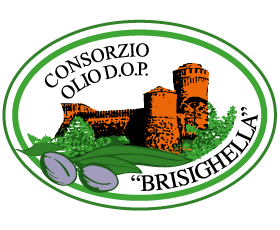
Consortium PDO oil Brisighella
Via Tebano, 45 – 48018 Faenza, RA
C.F.: 01358680393
Phone 0546 81103
Fax 0546 81497
info@brisighelladop.it
The origins of Brisighella stretch far back in time. Findings in the Tanaccia cave, near the Monticino-Limisano road leading to Riolo Terme, show the presence of settlements dating to the Neolithic and Bronze Age. The valley was then occupied by populations of Celtic origin, as revealed by the necropolis found in the hamlet of San Martino in Gattara.
Some place names refer to Gallic populations, however: for example, Rontana (‘high place’) and Brisighella itself, which some associate with the root ‘brix’ (‘summit’, ‘high ground’). There are many other interpretations, though, such as the claim that the name derives from the Veneto term bressichella (fragment), i.e., the little part of the Venetian Republic in Romagna.
Others still maintain that the origin is Greek, deriving from braxica (cabbage) and referring to a place suited to the cultivation of this vegetable.
When the Romans occupied these lands, they built the via Faentina road (then called the via Antonina after the Roman emperor Antoninus Pius), which branched off the via Emilia and crossed the Apennines. The road, no wider than a mule track, was traversed by the salt caravans coming from Cervia and heading to Rome. We still find traces of it in the local place names today. Quartolo, for example, is located at the fourth (quarto) mile from the beginning of the road, counting from Faenza, Rio Quinto at the fifth (quinto), and also Pieve del Thò, or eighth, indicates the eighth mile, and Ponte Nono, the ninth (nono).
The founding of the present-day town is traditionally attributed to Maghinardo Pagani da Susinana, considered Romagna’s greatest medieval condottiero (mercenary company captain). Today, the neoclassical town hall bears his name.
In 1290, on the outcrop where the Clock Tower stands, Maghinardo had a tower erected in opposition to Francesco Manfredi, Lord of Faenza. It was constructed from large chalk blocks, and the town of Brisighella we know today grew up at the base of this tower.
Art, history and architecture come together to form a heady mix in Brisighella. Because standing even for just a moment looking out from the balconies of the clock tower, the fortress or Monticino sanctuary means enjoying extraordinary views and unusual perspectives.
And as you take in the picturesque town below, you’ll probably feel the urge to explore the treasures hiding behind those charming views.
The origins of Brisighella stretch far back in time. Findings in the Tanaccia cave, near the Monticino-Limisano road leading to Riolo Terme, show the presence of settlements dating to the Neolithic and Bronze Age. The valley was then occupied by populations of Celtic origin, as revealed by the necropolis found in the hamlet of San Martino in Gattara.
Some place names refer to Gallic populations, however: for example, Rontana (‘high place’) and Brisighella itself, which some associate with the root ‘brix’ (‘summit’, ‘high ground’). There are many other interpretations, though, such as the claim that the name derives from the Veneto term bressichella (fragment), i.e., the little part of the Venetian Republic in Romagna.
Others still maintain that the origin is Greek, deriving from braxica (cabbage) and referring to a place suited to the cultivation of this vegetable.
When the Romans occupied these lands, they built the via Faentina road (then called the via Antonina after the Roman emperor Antoninus Pius), which branched off the via Emilia and crossed the Apennines. The road, no wider than a mule track, was traversed by the salt caravans coming from Cervia and heading to Rome. We still find traces of it in the local place names today. Quartolo, for example, is located at the fourth (quarto) mile from the beginning of the road, counting from Faenza, Rio Quinto at the fifth (quinto), and also Pieve del Thò, or eighth, indicates the eighth mile, and Ponte Nono, the ninth (nono).
The founding of the present-day town is traditionally attributed to Maghinardo Pagani da Susinana, considered Romagna’s greatest medieval condottiero (mercenary company captain). Today, the neoclassical town hall bears his name.
In 1290, on the outcrop where the Clock Tower stands, Maghinardo had a tower erected in opposition to Francesco Manfredi, Lord of Faenza. It was constructed from large chalk blocks, and the town of Brisighella we know today grew up at the base of this tower.
Art, history and architecture come together to form a heady mix in Brisighella. Because standing even for just a moment looking out from the balconies of the clock tower, the fortress or Monticino sanctuary means enjoying extraordinary views and unusual perspectives.
The town of Brisighella is proudly part of the “Città dell’Olio” association.
This accolade enables our jewel of a town to build on its strong cultural identity and the quality of its products through celebrations, events and regional marketing projects.